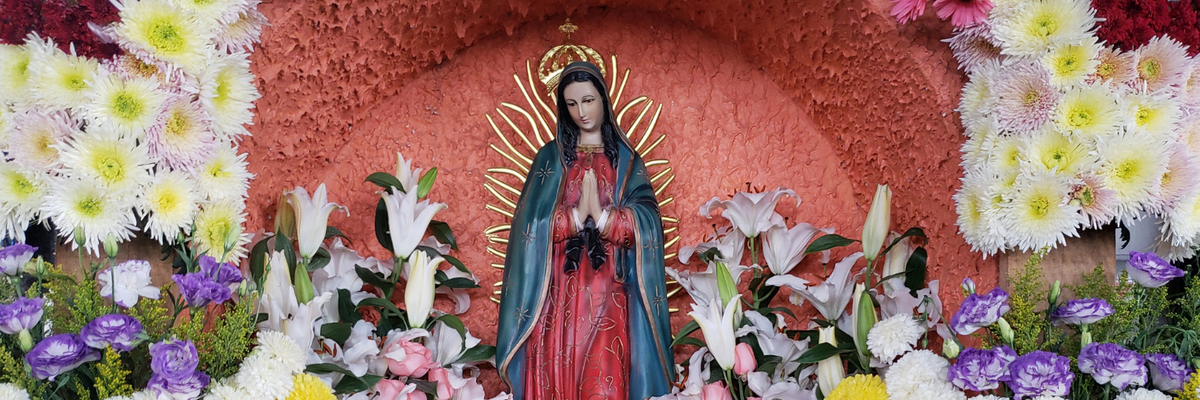From Conquest to Cultural Icon: La Virgin's Complicated Journey

Latinos have a profound connection to the Catholic religion, an enduring relic of Spanish colonization. Praying, rituals, and generally thanking God are important cultural and religious habits deeply seeded in the culture.
December 12th is a significant religious and cultural celebration in Mexico, which marks the culmination of events told in the famous story of the Virgin Mary appearing to Juan Diego, a peasant, in Mexico City as a dark-skinned woman who spoke to Diego in his native tongue, Náhuatl. The day is recognized as the feast day of Our Lady of Guadalupe, and the date it is observed with pilgrimages, processions, Masses, and various festivities.
Why did the Virgin Mary Appear before Juan Diego?
According to the well-told story, Juan Diego, a peasant in Mexico, claimed to have seen the Virgin Mary on the Hill of Tepeyac. She told Juan Diego to instruct the local bishop to build a church in her honor on that site, but when Juan Diego delivered the message to the bishop, he didn't believe Juan Diego, who after all was just a lowly peasant.
Undeterred, the Virgin appeared to Juan Diego again, and this time, she told Juan Diego to gather roses, which were out of season, and present them to the bishop. Juan Diego complied and when he opened his cloak to reveal the roses, an image of the Virgin Mary miraculously appeared on the fabric. This image is now venerated as the Our Lady of Guadalupe.

Photo by Emmanuel Acua on Unsplash
The Site of the Virgin Mary Appearance
The Basilica of Our Lady of Guadalupe in Mexico City is one of the world's most visited Catholic pilgrimage sites and attracts millions of visitors a year. It stands on the site where the Virgin Mary is believed to have appeared to Juan Diego on the Hill of Tepeyac in 1531. The Basilica complex consists of the old basilica, known as the Basilica of Santa María de Guadalupe, and the new basilica, officially named the Basilica of Our Lady of Guadalupe. The old basilica was built in the 1700s, but due to structural issues, a new basilica was constructed nearby and completed in 1976.
The Basilica of Our Lady of Guadalupe and the Basilica of Santa María de Guadalupe as seen from the top of the hill of Tepeyac.



The Streets are Filled with Processions
Many Mexican and other Latin-American households pay homage to the Virgin by hanging photos or building altars of all sizes year-round. During the day of the Virgin, the streets are filled with people vibrating with love for Nuestra Señora Salvadora. The streets are filled with resounding conversations and colorful flowers, and as people find Guadalupe, they walk the streets and honor her presence. In Mexico City, people march the entire street to the Basílica de Guadalupe, singing, surrounded by food stands, and people swelling with love, devotion, and pride of the Virgen de Guadalupe.
The march can be so deeply meaningful to some people that they march on their knees.

miguel.cardenas, CC BY 2.0, via Wikimedia Commons
It's a Celebration and a Family Affair
Figures of la Virgen, dancing to the rhythm of the drums, incienso, fireworks, and food can be found in cities throughout Mexico. It's a joyous moment for many families because it’s finally the day to celebrate and thank her for her blessings. You can find la Virgen de Guadalupe paintings on random walls that often get serenaded with rancheras and baladas.
The vibe is a community celebration. Children run around dressed as little Dieguitos, with their painted bigotes, sandalias, and sombreros. In churches, you can see people recreating the tale, putting on a big scene of how it all happened: the manto, the flowers, and the mysticality of it all.

Photo by Juan Manuel Montejano Lopez
La Virgen de Guadalupe: Symbol of Hope
People vibrate with pride and love, while many others publicly declare how their lives were changed by miracles la Virgen de Guadalupe created for them.
La Virgen de Guadalupe is now a beacon of hope and light for millions of Mexicans but she's also turned into a cultural icon for many others. Understanding the origin story of the Virgin helps explain why the day is so sacred, but it also helps explain why she's such a staple to Mexican culture, even for the non-religious.

Photo by Friar Sergio Serrano, OP


 Photo by
Photo by  Photo by
Photo by  Photo by
Photo by  Photo by
Photo by  Photo by
Photo by  a group of monarch butterflies on a treePhoto by
a group of monarch butterflies on a treePhoto by 

